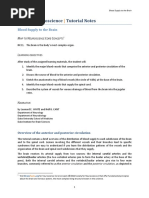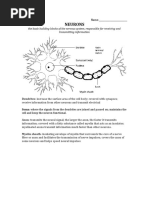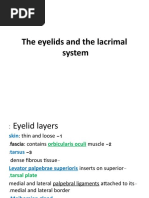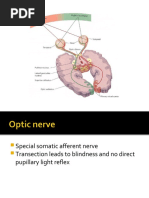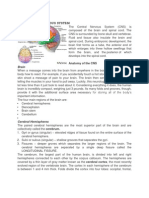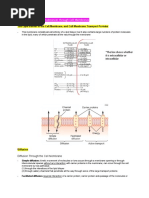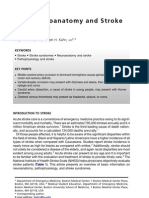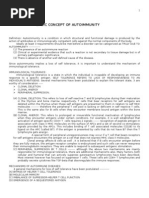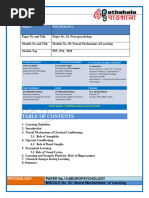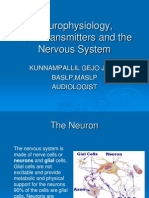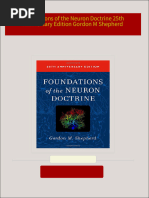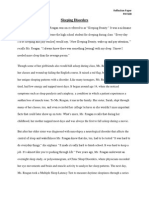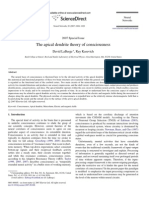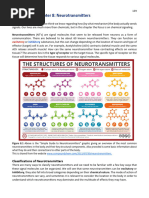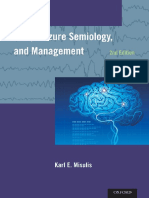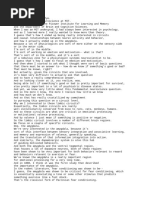Synapse
Synapse
Uploaded by
Sinan SaCopyright:
Available Formats
Synapse
Synapse
Uploaded by
Sinan SaCopyright
Available Formats
Share this document
Did you find this document useful?
Is this content inappropriate?
Copyright:
Available Formats
Synapse
Synapse
Uploaded by
Sinan SaCopyright:
Available Formats
SYNAPSE
Nerve signals are transmitted from one nerve cell to the next through interneuronal junctions called synapses. This word comes from the Greek syn (together) and haptein (join). The synaptic transmission is not a simply nerve impulse conduction, but a very complex process. I. CLASSIFICATION OF SYNAPSES A. According to the way in which the nerve impulse is transmitted from one nerve cell to another, the synapses can be divided in: y Electrical synapse, which is characterized by a narrow space between the two nerve cells and by the presence of the so called gap junctions. These are small protein tubular structures, which allow the free movement of ions from one cell to the other, and let the nerve impulse pass directly from one neuron to the other. It is believed that in humans this type of synapse is present only in the vestibular nuclei. Chemical synapse. In this type of synapse, the first neuron secretes a chemical substance called a neurotransmitter which is released in the synaptic space and which will act on the second neuron. The vast majority of the synapses in the human brain are chemical synapses. Chemical synapses are slower than electrical ones but are also far more flexible.
B. According to the parts of the 2 neurons that establish the synaptic contact, the synapses can be: y y y y Axo-dendritic Axo-somatic Axo-axonic Dendro-dendritic
C. According to the effects produced on the postsynaptic neuron, the synapses can be: y y Excitatory, if they tend to depolarize and activate the postsynaptic neuron Inhibitory, if they tend to hyperpolarize and inhibit the postsynaptic neuron
II.PHYSIOLOGIC ANATOMY OF THE SYNAPSE Synapses usually occur between the axon of a presynaptic neuron and a dendrite or cell body of a postsynaptic neuron. Electron microscopic studies of the synapse have shown that the synapse is composed by:
1. The presynaptic terminals 2. The synaptic cleft 3. The postsynaptic membrane
1. The presynaptic terminals (of the presynaptic neuron): At a synapse, the end of the axon is 'swollen' and referred to as an end bulb or synaptic knob or terminal buttons. Within the end bulb are found lots of synaptic vesicles, which contain neurotransmitters. These neurotransmitters will be released into the synaptic cleft. Because the release of neurotransmitters expends large amount of energy, mitochondria are usually plentiful in this region of the neuron. Mitochondria provide adenosine triphosphate (ATP), which is required to synthesize new neurotransmitter molecules. Neurons in the brain and the cord differ in the number of presynaptic terminals, which may range from only a few to several hundred thousand. These differences make neurons in different parts of the nervous system react differently to incoming signals and therefore perform different functions.
2. The synaptic cleft: Between the end bulb and the dendrite (or cell body) of the post-synaptic neuron, there is a gap commonly referred to as the synaptic cleft. The synaptic cleft has usually a width of 20-30 nm. This means that pre- and post-synaptic membranes do not actually come in contact and that the impulse cannot be transmitted directly. Rather, the impulse is transmitted by the release of chemicals called chemical neurotransmitters, which act on the postsynaptic membrane 3. The postsynaptic membrane belongs to the second neuron and it is the membrane immediately under the nerve terminal. It appears to be thicker than the membrane outside the synapse and it contains receptors for neurotransmitters. The receptors are protein molecules that have 2 distinct parts: one is binding the specific neurotransmitter and the other is called the ionophore and is responsible for the postsynaptic effect. Each type of neurotransmitter has a molecular form that lets it bind to the right receptor on the second neuron to produce its particular effect.
III.THE SYNAPTIC TRANSMISSION The process by which the information is communicated from one neuron to the next is called synaptic transmission and can be broken into 6 steps: 1. Neurotransmitter synthesis: first of all, the neurotransmitter has to be synthesized either in the nerve terminal or in the soma of the neuron. From the soma, the neurotransmitter will be transported into the nerve terminal. 2. The storage of the neurotransmitter: the neurotransmitter, once synthesized, is stored in vesicles. When an action potential in the presynaptic neuron reaches the synapse, the vesicles are ready to pass it to the next neuron by releasing the stored neurotransmitter. The storage is necessary for the case in which the neuron discharges action potentials more rapidly than the neurotransmitter can be synthesized. 3. The release of the neurotransmitter into the synaptic cleft: when an action potential arrives at the terminal, it will depolarize it. The depolarization of the end bulb cause some voltage-dependent calcium (Ca2+) channels embedded in the presynaptic membrane to open and Ca2+ enters the cell. The calcium ions cause the transmitter vesicle to bind to and fuse with the presynaptic membrane. Finally, the vesicles open to the exterior and the neurotransmitter is released into the synaptic cleft. This process is called exocytosis. Following exocytosis, the vesicular membrane, presently a continuous extension of the pre-synaptic membrane, forms a pit and pinches off into the terminal to form a new, vacant vesicle. This vesicle is then either recycled and refilled with more of the neurotransmitter, or sent to the cell body, where it is broken down, processed into a new vesicle, and transported to the terminal where it can then be filled with the neurotransmitter. The quantity of the neurotransmitter released into the synaptic cleft depends on the number of calcium ions that have entered the neuron. 4. The crossing of the synaptic cleft: The neurotransmitter crosses the synaptic cleft by Brownian movement. Once it reaches the postsynaptic membrane, it will bind to specific neurotransmitter receptors. The neurotransmitter thus acts somewhat like a key. If it is the right shape for the receptors on the next neuron, it will produce an effect on that neuron. 5. The activation of postsynaptic neuron: The neurotransmitter will be recognized and bound by the specific neurotransmitter receptors found on the postsynaptic membrane. The receptors are membrane proteins consisted of two parts: a binding component that protrudes outward from the membrane into the synaptic cleft and an ionophore component that passes through membrane and that is either an ion channel or an enzyme. So, the binding of the neurotransmitter to the specific receptor either opens an ion channel, or activates an internal metabolic change inside the cell. The ion channels act quickly (in 1-2 milliseconds) to depolarize or hyperpolarize the postsynaptic neuron. In this ether is a fast synaptic transmission. The enzyme receptors act slower and their effects last more (hundreds of milliseconds, minutes). This slow synaptic transmission is important in some forms of memory.
6. After its recognition by the receptor, the neurotransmitter must be inactivated so that it does not continually occupy the receptor sites of the postsynaptic cell. In this way the effect of a particular neurotransmitter is restricted to a particular synapse at a given time. If the neurotransmitter wouldn t be inactivated, there would be a constant stimulation of the postsynaptic neuron. Some neurotransmitters are removed from the synaptic cleft by special transporter proteins on the presynaptic membrane. These transporter proteins carry the neurotransmitter back into the presynaptic cell. This is the case of monoamines. In the presynaptic cell, they are either incorporated into new vesicles or metabolized by some enzymes (monoamineoxidase or catechol-O-methyl transferase). Not all neurotransmitters are recycled by the presynaptic cell. Some neurotransmitters quickly diffuse away from the receptors into the surrounding medium. This is the case for peptide neurotransmitters. Other neurotransmitters, such as acetylcholine, have a specialized enzyme for inactivation right in the synaptic cleft called acetyl cholinesterase (AChE).
IV. TYPES OF FAST POSTSYNAPTIC RESPONSES Binding of the neurotransmitter to their specific receptors on the postsynaptic membrane sometimes activate the postsynaptic neuron, sometimes inhibit it. Excitatory postsynaptic potential (EPSP) When the neurotransmitter depolarizes the postsynaptic membrane, it is said to produce an excitatory postsynaptic potential. The depolarization is explained by opening of Na+ channels, which enters the cell according to its electrochemical gradient and shifts the membrane potential closer to the threshold for action potential generation and so renders the postsynaptic membrane more excitable. EPSP reaches its peak value within 1-5 msec of the arrival of the action potential, lasts about 15-20 msec and rarely exceeds a few millivolts. EPSP is not an all-or-none event, but are graded with the intensity of activation. The EPSP that occurs as a result of activation of one individual synapse has low amplitude. This means that a single EPSP usually cannot reach the threshold for eliciting an action potential and therefore cannot generate an action potential in the second neuron. A propagated action potential is given by summation. The temporal summation refers to the repeated activation of the same synapse. With each activation of the synapse the membrane potential of the second neuron depolarizes little by little until it reaches the threshold. The spatial summation refers to activation of different synapses on different part of the cell at the same time, leading to a high enough depolarization of the postsynaptic membrane to generate the action potential. Inhibitory postsynaptic potential (IPSP) When the neurotransmitter hyperpolarizes the postsynaptic membrane, it is said to produce an inhibitory postsynaptic potential. IPSP is explained either by opening the K channels, allowing K to leave the cell and render the membrane more negatively charged on the inside or by opening the Cl channels, allowing Cl to enter the cell, with the same result. AS the EPSP, IPSP reaches its peak within 1-5 msec from the arrival of an action potential, lasts for 20 msec and has amplitude of a few millivolts. During the IPSP the postsynaptic neuron is less excitable than normal. IPSP is allows graded with the intensity of activation and can summate with EPSP or others IPSP, temporally or spatially. If an IPSP tends to decrease the membrane potential to a more negative value and an EPSP tends to increase it at the same time, their effects can nullify each other. Or, if a neuron is being excited by an EPSP, then
an inhibitory signal from another neuron can reduce the postsynaptic potential to less than the threshold value for excitation. On short, the changes in the membrane potential of a neuron due to the synaptic activity occurring all over its surface determine its ability to generate an action potential. The same stimulus can trigger an action potential in an excitatory synapse if the membrane is already relatively depolarized by the activity of various other excitatory synapses or the same stimulus may be not sufficient to fire an action potential in the postsynaptic neuron if its membrane is already hyperpolarized by some other inhibitory synapses.
V. SPECIAL CHARACTERISTICS OF THE SYNAPTIC TRANSMISSION 1. One way conduction: because only the terminal buttons contain neurotransmitters and only the postsynaptic membrane contains receptors for neurotransmitters, synapses transmit the signal in one single direction: from the presynaptic neuron to the postsynaptic neuron. This is different from the conduction in one nervous fiber, in which the action potential can be transmitted both ways. 2. Synaptic delay: in synaptic transmission there is a delay of 0.5 msec. This time is needed for release, diffusion and action of the neurotransmitter on the postsynaptic membrane. The higher the number of synapses in a neuronal circuit, the longer is the duration for nervous impulse to reach the target. 3. Fatigue of synaptic transmission: when excitatory synapses are repetitively stimulated, the number of discharges by the postsynaptic neuron is at first very great, but it becomes less in a few milliseconds. This is called synaptic fatigue and is mainly due to exhaustion of the stores of neurotransmitter in the terminal buttons. The development of fatigue is a protective mechanism against excessive neuronal activity, as when areas of nervous system become overexcited, fatigue causes them to lose this excess excitability after a while. 4. Effects of hypoxia and drugs on synaptic transmission Because synaptic transmission is energy consuming, it depends on an adequate supply of oxygen. Lack of oxygen can cause cessation of synaptic transmission, as in the lack of oxygen there is no ATP synthesis. This is seen when the cerebral circulation is interrupted and when the person becomes unconscious within 3-5 seconds. As for drugs, most anesthetics exert their effects on synapses, either by increasing the release of inhibitory neurotransmitter, or by decreasing the excitatory neurotransmitters. Caffeine in coffee, theophyline in tea and theobromin in cocoa increase neuronal excitability by reducing the threshold for excitation. 5. Temporal and spatial summation (see above) 6. Electrical inexcitability: the postsynaptic membrane cannot generate an action potential as a consequence of some local currents, as this membrane does not contain voltage-gated ion channels. 7. Post-tetanic facilitation: if repeated impulses activate an excitatory synapse, then is allowed to rest and then is activated again, it becomes more excitable for a period of seconds and minutes (and
sometimes even hours). This phenomenon is caused by accumulation of calcium ions in the terminal button in case of repeated action potential coming to that terminal (remember the amount of the neurotransmitter released into the synaptic cleft depends on the number of calcium ions that have entered the neuron). 8. Convergence, divergence: One neuron can receive impulses coming from more neurons (convergence) and can send impulses to more than one neuron (divergence). 9. After-discharge is given by reverberating circuits and defines the prolonged and multiple response of a neuron to stimulation by one single afferent pathway. In this case, the intercalary neurons are placed in a closed circuit and will cause a prolonged activation of the efferent neuron.
VI. NEUROTRANSMITTERS Neurotransmitters are chemical molecules that ferry nerve impulses across the synapse from one neuron to the next. Each type of neurotransmitter has a molecular shape that lets it bind to the right site on the second neuron to produce its particular effect. The neurotransmitters can be divided into 6 classes: 1. Esters: acetylcholine (Ach) 2. Monoamines: nor epinephrine (noradrenalin), dopamine, serotonin 3. Amino acids: glutamate, gamma-amino butyric acid (GABA) 4. Purines: ATP 5. Peptides: encephalins, substance P 6. Inorganic gases: NO Usually, only a single type of transmitter is released by each type of neuron. A certain neurotransmitter may be more highly concentrated in one area of the brain than it is in another. In addition, the same neurotransmitter may elicit a variety of different responses based on the type of tissue being targeted. Some nerve terminals are known to contain 2 different kinds of neurotransmitter, which are released at the same time when the nerve terminal is activated. For example, the parasympathetic nerves of the salivary glands release both Ach, which increases salivary secretion and vasoactive intestinal peptide (VIP), which increases the local blood flow. Neurotransmitters are divided into two categories according to the effect that they have on the second neuron once they are released into the synaptic cleft. Neurotransmitters that help this neuron to propagate the nerve impulse are classified as excitatory neurotransmitters. Such excitatory neurotransmitters are Ach in most cases, noradrenalin in most cases, glutamate. Neurotransmitters that reduce the likelihood of this neuron s propagating the impulse are called inhibitory neurotransmitters. Such neurotransmitters are GABA and glycine.
VII. THE NEUROMUSCULAR JUNCTION The neuromuscular junction is a specific type of synapse; in this case the nerve endings make the junction with a muscle fiber. The skeletal muscle fibers are innervated by large, myelinated nerve fibers that originate in the large alpha motoneurons of the anterior horns of the spinal cord. Each nerve branches many times and innervates 3 to several hundred muscle cells. One neuron and the muscle fibers innervated by it form a motor unit. The neuromuscular junction is usually placed in the middle of the muscle fiber. The nerve terminal invaginate into the muscle fiber. This means that nerves are fairly firmly attached to the muscles they innervate. The invagination of the muscle fiber is called the synaptic gutter. At the bottom of it there are many small folds of the membrane, which increase the surface area of the postsynaptic membrane. The neurotransmitter of the neuromuscular junction is always Ach, which has an excitatory effect on muscle fiber. A single action potential that reaches the nerve terminal is able to produce the depolarization of muscle cell membrane; for neuromuscular junction there is no need of summation. From the synaptic gutter, the depolarization travels very rapidly in both directions to the muscle fiber ends. Muscle fiber depolarization will be followed by the muscle fiber contraction. Ach will be rapidly removed from the neuromuscular junction, being degraded by the enzyme acetyl cholinesterase and thus preventing muscle re-excitation after the fiber has recovered from the first action potential. Drugs that affect neurotransmission y Drugs with Ach-like effects: metacholine, nicotine, carbachol have the same effects as ACh on muscle fibers. Because they are not decomposed by acetyl cholinesterase, their effect lasts for minutes and hours, causing spasms. y Drugs that stimulate neuromuscular transmission by inactivating acetyl cholinesterase: neostigmine, diisopropylfluorophosphate. They cause Ach to accumulate and repetitively stimulate the muscle fiber, producing spasms. y Drugs that block neuromuscular transmission: curariform drugs (d-tubocurarine) prevent transmission of impulses from nerve terminals to muscle fibers. Slow synaptic transmission The ionophore can be either an ion channel or an enzyme. This enzyme can act by: y activating the metabolic machinery of the cell (for instance to synthesize AMP, which is a so called second messenger and triggers many different effects in the cell) y activating genes and thus leading to synthesis of new protein molecules, such as receptor molecules for postsynaptic membrane y Activating protein kinases, that split some protein molecules and thus decreasing the number of receptors, for instance the effects of activating such synapses occur in minutes, hours, days. For this reason, the neurotransmitters causing such effects are sometimes called neuromodulators. Neurotransmitter can be classified according to the rapidity of their effects in: y fast acting neurotransmitters, such as Ach, amines, amino acids (GABA, glycine) they all have small molecules and they cause most of the acute responses of the nervous system(transmission of sensory signals to the brain, motor signals to the muscle) y slow acting neurotransmitters, such as neuropeptides: substance P, VIP
You might also like
- TBRBiology 1Document372 pagesTBRBiology 1Fabliha Huq100% (11)
- Leech Lab ReportDocument14 pagesLeech Lab Reportapi-339485098No ratings yet
- Basal GangliaDocument4 pagesBasal GangliaOvolime UbodiomNo ratings yet
- Resting Membrane, Graded, Action Potentials AtfDocument4 pagesResting Membrane, Graded, Action Potentials AtfdaphneNo ratings yet
- Neuromuscular DisordersDocument3 pagesNeuromuscular Disordersapi-321778954No ratings yet
- Excitation of HeartDocument17 pagesExcitation of HeartdevdsantoshNo ratings yet
- Medical Neuroscience Tutorial Notes: Blood Supply To The BrainDocument6 pagesMedical Neuroscience Tutorial Notes: Blood Supply To The BrainsoyyosoloyoNo ratings yet
- (6P) Basic Concepts in Immunity and InflammationDocument6 pages(6P) Basic Concepts in Immunity and InflammationNegrus Stefan100% (1)
- What Is AstigmatismDocument2 pagesWhat Is AstigmatismJA QuibzNo ratings yet
- Epidural Hematoma Neuro SurgeryDocument2 pagesEpidural Hematoma Neuro SurgeryA Novita Dewi AryantiNo ratings yet
- NeuronsDocument1 pageNeuronsdmjuncalNo ratings yet
- 2 General-PathologyDocument2 pages2 General-PathologyJOUBELLE NUR-NISA NAVALNo ratings yet
- Encephalitis Is An Acute Inflammation of The Brain. Encephalitis With Meningitis IsDocument4 pagesEncephalitis Is An Acute Inflammation of The Brain. Encephalitis With Meningitis IsDivya GuptaNo ratings yet
- Blood Supply of Cerebral CortexDocument3 pagesBlood Supply of Cerebral CortexashrafNo ratings yet
- The Brainstem: Ot1024: NeuroscienceDocument6 pagesThe Brainstem: Ot1024: NeuroscienceReyna MedinaNo ratings yet
- Lens IntroductionDocument40 pagesLens Introductionapi-3756649100% (1)
- Neuroglia - PDF (Ingles)Document29 pagesNeuroglia - PDF (Ingles)Médecin Adrian TGNo ratings yet
- Brief CGA TemplateDocument3 pagesBrief CGA TemplateMagister Keperawatan GerontikNo ratings yet
- Delirium Power Point PresentationDocument15 pagesDelirium Power Point Presentationfrancis00090100% (1)
- 6 - 7 ConjunctivaDocument16 pages6 - 7 ConjunctivaMariam QaisNo ratings yet
- The Pupillary Light Reflex PathwayDocument5 pagesThe Pupillary Light Reflex PathwayNauli PanjaitanNo ratings yet
- 06 Refractive ErrorDocument12 pages06 Refractive ErrorMwanja MosesNo ratings yet
- The EyelidsDocument64 pagesThe EyelidsSarahNo ratings yet
- Nervous System: Chapter # 7Document69 pagesNervous System: Chapter # 7saddam ud dinNo ratings yet
- Visual PathwayDocument39 pagesVisual Pathwayhuman anatomyNo ratings yet
- How To Administer Eye Drops and Ointments PDFDocument3 pagesHow To Administer Eye Drops and Ointments PDFDionicia Chandrika0% (1)
- Major Arteries and Their BranchesDocument6 pagesMajor Arteries and Their BranchesPriya Farooq100% (1)
- The Central Nervous System: BrainDocument12 pagesThe Central Nervous System: BrainsheinelleNo ratings yet
- A Brief Cognitive Assessment Tool For SchizophreniaDocument8 pagesA Brief Cognitive Assessment Tool For SchizophreniaRatriningdyah DewiNo ratings yet
- Physiology of Vision by DR ShahabDocument81 pagesPhysiology of Vision by DR ShahabShahabuddin ShaikhNo ratings yet
- Neurotransmitters PDFDocument23 pagesNeurotransmitters PDFБакытNo ratings yet
- Consultation Liaison PsychiatryDocument38 pagesConsultation Liaison Psychiatryfredrrg100% (1)
- Study Design IDocument28 pagesStudy Design IKareem DarwishNo ratings yet
- Accomodation of EyeDocument5 pagesAccomodation of Eyeshumaila khanNo ratings yet
- The Effects of Alcohol and Drug AbuseDocument5 pagesThe Effects of Alcohol and Drug AbuseAlma Garcia Fama100% (1)
- Med Chem ANS DrugsDocument168 pagesMed Chem ANS Drugshailu tasheNo ratings yet
- Physiology Chap4 (Transport of Substances Through Cell Membrane)Document5 pagesPhysiology Chap4 (Transport of Substances Through Cell Membrane)Man Dejelo100% (1)
- NEURODocument201 pagesNEUROAilyn LoroNo ratings yet
- Conjuctiva 1Document47 pagesConjuctiva 1maleeha shahzadNo ratings yet
- Two Major FormsDocument5 pagesTwo Major FormsKath CuevasNo ratings yet
- Antimicrobial DrugsDocument20 pagesAntimicrobial Drugsnadar shahNo ratings yet
- Anatomy of Eyelid: Presenter:-Dr. Vijayalaxmi Moderator:-Dr. SanjanaDocument49 pagesAnatomy of Eyelid: Presenter:-Dr. Vijayalaxmi Moderator:-Dr. SanjanaRidhi Bhandari100% (1)
- Negotiation SkillDocument15 pagesNegotiation Skillmamita gurung100% (1)
- Basic Neuroanatomy and Stroke Syndromes PDFDocument15 pagesBasic Neuroanatomy and Stroke Syndromes PDFFrancisco A. Villegas-López100% (2)
- Clinical Skills Week 1Document3 pagesClinical Skills Week 1Aishah SiddiqahNo ratings yet
- The Bony OrbitDocument3 pagesThe Bony OrbitxxyumeNo ratings yet
- OCEAN of The Earth and Water of The OCEANDocument4 pagesOCEAN of The Earth and Water of The OCEANrotsacreijav77777No ratings yet
- Vision PhysiologyDocument37 pagesVision PhysiologyAnshu MishraNo ratings yet
- Chapter 13: Oceans and CoastlinesDocument83 pagesChapter 13: Oceans and CoastlinesRen SyNo ratings yet
- Hiv HaartDocument12 pagesHiv HaartMalueth AnguiNo ratings yet
- What Are Extrapyramidal SymptomsDocument2 pagesWhat Are Extrapyramidal SymptomscristieristiieNo ratings yet
- Basal Ganglia: by DR Siti Nordiana DollahDocument49 pagesBasal Ganglia: by DR Siti Nordiana DollahVincent Lau Bi ShengNo ratings yet
- Pharmacology MnemonicsDocument17 pagesPharmacology MnemonicsIk-ik MiralNo ratings yet
- Basic Concept of AutoimmunityDocument3 pagesBasic Concept of AutoimmunityLakshya J Basumatary100% (4)
- OlfactionDocument12 pagesOlfactionbakex645No ratings yet
- Case StudyDocument40 pagesCase StudySheryhan BayleNo ratings yet
- Lecture IV AstigmatismDocument18 pagesLecture IV AstigmatismHenok BirukNo ratings yet
- 3.7 Organ Transplantation PDFDocument3 pages3.7 Organ Transplantation PDFbrownieallennNo ratings yet
- Sensations and Sensory Pathways General Senses Test Procedure Normal Result Abnormal Result Clinical InterpretationDocument5 pagesSensations and Sensory Pathways General Senses Test Procedure Normal Result Abnormal Result Clinical InterpretationAbby MataNo ratings yet
- SynapseDocument12 pagesSynapseSweety DhillonNo ratings yet
- Bio Notes SynapseDocument4 pagesBio Notes SynapseLeeroy MafuruseNo ratings yet
- Synaptic TransmissionDocument17 pagesSynaptic Transmissionyanaasv05No ratings yet
- Lecture 2Document6 pagesLecture 2Vivek ChaudharyNo ratings yet
- Introduction To CNS: Montoya, Irene Jane M. MS PharmacyDocument28 pagesIntroduction To CNS: Montoya, Irene Jane M. MS PharmacyYan MontoyaNo ratings yet
- BioPsy Week 4-5Document39 pagesBioPsy Week 4-5ayşe tankırNo ratings yet
- The Journal of Physiology - 1988 - Hounsgaard - Bistability of Alpha Motoneurones in The Decerebrate Cat and in The AcuteDocument23 pagesThe Journal of Physiology - 1988 - Hounsgaard - Bistability of Alpha Motoneurones in The Decerebrate Cat and in The AcuteD.S.M.No ratings yet
- Neural LearningDocument11 pagesNeural LearningsodumsuvidhaNo ratings yet
- Section 2: Signal Transmission Between The NeuronsDocument123 pagesSection 2: Signal Transmission Between The NeuronsAna Crigan VlasNo ratings yet
- NeurophysiologyDocument200 pagesNeurophysiologyashley nicholeNo ratings yet
- Receptors and Coding Logic For Bitter TasteDocument6 pagesReceptors and Coding Logic For Bitter Tastetiwoka6337No ratings yet
- Principles of Neural and Hormonal CommunicationDocument75 pagesPrinciples of Neural and Hormonal CommunicationPam Stuck RhoadesNo ratings yet
- 1 Unit Three - Excitable Tissues (Nerve)Document38 pages1 Unit Three - Excitable Tissues (Nerve)tadele1075% (4)
- Neurophysiology, Neurotransmitters and The Nervous SystemDocument69 pagesNeurophysiology, Neurotransmitters and The Nervous SystemKUNNAMPALLIL GEJO JOHN100% (2)
- Part I: Sample Multiple Choice QuestionsDocument8 pagesPart I: Sample Multiple Choice Questionsjasmin100% (1)
- CH 48Document11 pagesCH 48randomtamaNo ratings yet
- Excitable TissueDocument117 pagesExcitable Tissueur.yared21100% (1)
- Download full Foundations of the Neuron Doctrine 25th Anniversary Edition Gordon M Shepherd ebook all chaptersDocument85 pagesDownload full Foundations of the Neuron Doctrine 25th Anniversary Edition Gordon M Shepherd ebook all chapterslaziritofan100% (7)
- Neuronal CommunicationDocument29 pagesNeuronal CommunicationSamantha CNo ratings yet
- Reflection Paper Phy108Document8 pagesReflection Paper Phy108VshamVijayNo ratings yet
- Neurorobotics Workshop For High School Students Promotes Competence and Confidence in Computational NeuroscienceDocument10 pagesNeurorobotics Workshop For High School Students Promotes Competence and Confidence in Computational NeuroscienceJoshua HernandezNo ratings yet
- Neuron Communication at SynapsesDocument74 pagesNeuron Communication at SynapsesShatha KhzaimiahNo ratings yet
- Matlab - Development of Neural Network Theory For Artificial Life-Thesis - MATLAB and Java CodeDocument126 pagesMatlab - Development of Neural Network Theory For Artificial Life-Thesis - MATLAB and Java CodeHotland SitorusNo ratings yet
- Apical Dendrite and Theory of Consiousness (La Berge, 2007)Document17 pagesApical Dendrite and Theory of Consiousness (La Berge, 2007)Gabriel ArteagaNo ratings yet
- Physiol Text CH 8 NeurotransmittersDocument35 pagesPhysiol Text CH 8 NeurotransmittersbrittomelishaNo ratings yet
- Chapter 11Document6 pagesChapter 11monkeyrowNo ratings yet
- 4 - Neural Conduction and Synaptic TransmissionDocument10 pages4 - Neural Conduction and Synaptic TransmissionElmer SalazarNo ratings yet
- Atlas of EEG, Seizure Semiology, and Management 2nd EdDocument384 pagesAtlas of EEG, Seizure Semiology, and Management 2nd Edsolecitodelmar100% (10)
- MCB80.2x V2 2k Optogenics V2FC JW - Edxmstr V1-30-EnDocument9 pagesMCB80.2x V2 2k Optogenics V2FC JW - Edxmstr V1-30-EnAnina YangNo ratings yet
- SynapsesDocument11 pagesSynapsesApple AcaNo ratings yet
- XII - Zoology Exercise QuestionsDocument34 pagesXII - Zoology Exercise Questionsmeerab uroojNo ratings yet






